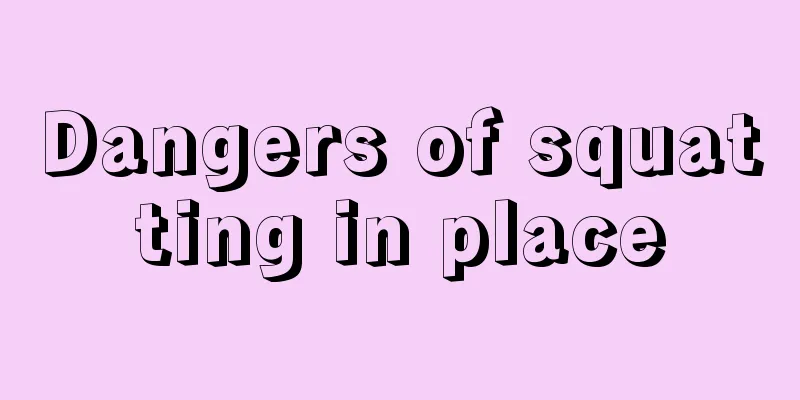Dangers of squatting in place

|
People's knees will bear four times the pressure of the body when squatting. If you squat for a long time, it will have a serious impact on the knees. Many people will exercise their leg muscles through squats. Although this method is very effective, it is very harmful to people's knees. Therefore, it is best not to do squats on the spot frequently. Let’s learn about the dangers of squatting in place with the editor. Introduction The basic movements are: keep your feet together, center your body straight, put your center of gravity on the front of your feet, hold your chest and abdomen in, relax your whole body, do not tilt your head back or tilt your head, always keep your legs together, try to keep your knees within your toes when squatting, squat completely and then slowly stand up, and repeat this many times. There are two methods of "squatting in place": slow squat and fast squat. Slow squat method Do 30 squats in a set, the more the better. The best time for fitness exercise is 15 to 30 minutes, or until you sweat. It is necessary to proceed step by step and gradually increase the amount. For example, only do 30 squats the first time, 60 squats each two times, and then gradually increase the number later. Slow squatting, the key is the word "slow", the slower the better. Why? Generally speaking, during a squat, when you squat to a certain angle, the leg muscles are exerting force. Beyond this angle, the thighs will automatically drop down, and when you stand up, they will just swing up, which often wastes the force of many leg muscle groups. If you squat slowly, you can effectively improve the strength of all parts of the leg muscles. The thighs can rise and fall smoothly at any angle without the feeling of rising or falling all of a sudden. This shows that every muscle group in the legs is working and the exercise is effective. What does “sweating is valuable” mean? There are three ways for a person to eliminate waste from the body: defecation, urine and sweat. 98% of sweat is water, and the remaining 2% includes urea, uric acid and salt. Sweating can not only cool the body, but more importantly, many garbage, waste and even toxins in the human body are excreted through the sweat glands. Therefore, proper sweating is like doing a general cleaning for the body, making you clean and clear, and your skin is smooth. This is why sweating is valuable. During the slow squatting process, you can add "deep breathing" and "finger extension and flexion" to practice. The "deep breathing" and "finger extension and flexion" methods are described in detail in the related entry "wall squat". Fast squat method The average is about 5 to 30 squats per minute. Young people can usually do about 200 to 300 squats, or even more, provided that they do not feel tired the next day. As the exercise progresses and the body is able to fully adapt, you can consider increasing the difficulty of the movements according to your personal preferences. Such as "barefoot squats", "arm-supported squats", "hands behind the back squats" and "squats to waste energy". Precautions First, as mentioned above, try to keep your knees within your toes when squatting. The purpose is to effectively stretch the entire spine, including the cervical, thoracic, lumbar, iliac and coccyx. I said "try to" rather than "must". The result of doing this is that the body will inevitably lean backward, and in a balanced state, the stretching effect of the spine can be effectively exercised. Second, during the squat process, the whole body should be relaxed, but the roots of the thighs should always maintain an upward tension; when squatting, just think about the navel, and when standing up, just think about the top of the head. When squatting, just think about the two points of "belly button" and "top of the head" and not think about anything else. This can avoid distraction and make squatting feel easier. Just know these basically. After completing the "deep squat on the spot" exercise every day, you can do some "small half squat" maintenance exercises and "half squat against the wall" correction exercises appropriately. For the content of “small half squat” and “half squat against the wall”, please view the entries “small half squat” and “half squat against the wall”. |
<<: What are the hazards of plastics when exposed to high temperatures
>>: What harm does sulfur do to the human body
Recommend
What is the difference between chives and leeks
In many cooking tutorials, sometimes leeks appear...
Causes of scar formation after double eyelid surgery
As many people's aesthetic standards continue...
Is the whitening of oral mucosa serious?
There are many reasons for the whitening of the o...
Can durian seeds be eaten raw?
Durian is a type of fruit, but it is different fr...
6 tips for teeth whitening to make your smile brighter
Many people are very concerned about skin whiteni...
The efficacy and function of Begonia papaya
In our lives, many people like to eat crabapples....
Why can't I close my mouth when I yawn?
If the human body does not pay attention to some ...
What is the normal value of alt
The alt value represents the function of the huma...
What are the Chinese patent medicines for treating headaches
Headache is one of the common diseases that bothe...
What's wrong with low blood pressure in late stage pancreatic cancer
Low blood pressure in the late stage of pancreati...
Should you use a curling iron on wet or dry hair?
Curling irons are a very common tool in life. Gir...
Can I drink green tea if I have chronic gastritis?
The treatment of chronic gastritis takes time, an...
What are the symptoms of mental retardation?
Mental retardation is a phenomenon of intellectua...
What are the benefits of massage
With the improvement of living standards, people ...
How to increase metabolism
Each of us has to metabolize every day. Metabolis...









